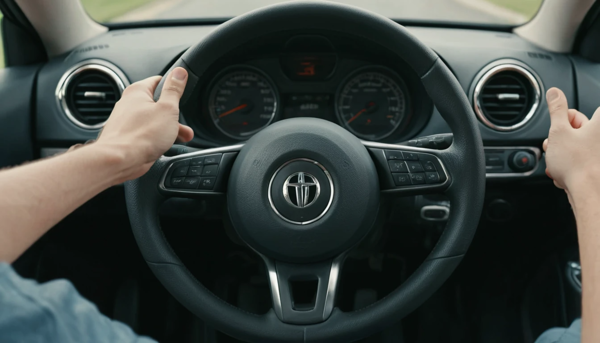Driving Tips
How To Drive A Manual Transmission – Master The Skill Fast!

How to drive a manual transmission car like a pro? Learn step-by-step tips to shift smoothly, avoid stalls, and feel confident behind the wheel.
How to Drive a Manual Transmission – Master the Stick Like a Pro 🚗
Ever watched someone smoothly glide through traffic in a manual car and thought—how do they make it look so easy?
Driving a stick shift can feel intimidating at first. But once you learn the rhythm, it’s like dancing with the car. Whether you’re getting ready for your first driving lesson or want to drive that old-school Mustang, you’re in the right place. We’ll go through it step by step, without any confusing jargon or pressure.
Understanding the Basics of Manual Transmission 🛠️
Before you drive, you’ve got to know what you’re handling. Unlike automatics, manual cars require the driver to manually shift gears based on speed and engine load. Here’s what you’ll use:
- Clutch Pedal (left foot): Disconnects the engine from the wheels
- Brake Pedal (right foot): Slows the car
- Gas Pedal (right foot): Speeds up the car
- Gear Stick: Changes gears (1st through 5th/6th + reverse)
Your left foot controls only the clutch. Your right foot manages both gas and brake. Balance is everything here.
Why Learn Manual? 🎯
Wondering if it’s worth the trouble? Here’s why many people love manual cars:
- Better control in snow or off-road
- Improved fuel efficiency (in some models)
- Lower maintenance costs
- More driver engagement—you feel the road
- It’s fun and empowering! 💪
The Right Way to Start a Manual Car 🚘
Let’s get hands-on (and feet-on). Here’s how to start a manual car safely:
- Press the clutch all the way down with your left foot
- Turn the ignition key or press Start while keeping the clutch down
- Shift into 1st gear
- Slowly release the handbrake
- Begin slowly releasing the clutch while gently pressing the gas
👉 Your goal: Let off the clutch slowly and evenly, without jerking or stalling.
Common Gear Positions in Manual Cars ⚙️
Most manual transmissions follow a standard H-pattern for gear shifting. Here’s a quick reference:
| Gear | Direction on Stick | Usage |
|---|---|---|
| 1st | Top Left | Starting from stop |
| 2nd | Bottom Left | Slow driving |
| 3rd | Top Middle | City driving |
| 4th | Bottom Middle | Moderate speeds |
| 5th | Top Right | Highway speeds |
| Reverse | Far Right or Down | Backing up |
Always press the clutch fully before moving the gear stick.
How to Move From a Stop Without Stalling 🔄
Stalling happens. It’s common when you’re new. But with practice, it gets easier.
Here’s the secret:
- Clutch down ➡️ Shift to 1st gear ➡️ Slowly let up clutch ➡️ Gently press gas
- Listen for the “bite point”. This is when the car starts moving.
💡 Tip: If you stall, don’t worry. Just press the clutch, brake, shift to neutral, and start again.
Shifting Gears Smoothly Without the Jerk 🌀
Here’s when to shift (speeds vary by car):
- 1st to 2nd: 10–15 mph
- 2nd to 3rd: 20–25 mph
- 3rd to 4th: 30–40 mph
- 4th to 5th: 45–55 mph
How to shift:
- Clutch in
- Release the gas
- Shift up
- Clutch out slowly while adding gas
🔥 Pro Tip: Smooth shifting feels easy when your foot and hand work together.
Understanding the Clutch “Bite Point” 🧩
The bite point is the perfect spot. You’ll know it when:
- The car slightly moves forward
- Engine noise lowers
- The RPM drops a little
Mastering this balance stops rolling backwards and stalling at lights.
How to Stop in a Manual Without Stalling 🛑
Stopping? Here’s what to do:
- Clutch in before the engine bogs down
- Brake smoothly
- Once stopped, shift to neutral
- Release the clutch
🧠 Remember: Clutch first, then brake. Don’t release clutch too early or you’ll stall.
Starting on a Hill Without Rolling Back ⛰️
Hill starts are scary for beginners. But with practice, you’ll get better:
Two safe methods:
- Handbrake method:
- Pull up handbrake
- Clutch in, 1st gear
- Slowly release clutch until bite point
- Release handbrake while pressing gas
- Quick foot method:
- Move foot from brake to gas quickly as you release clutch
📌 Practice on a quiet incline first. Confidence grows with practice.
Downshifting Like a Pro 🔻
Downshifting isn’t just for slowing down. It also helps control your car. Here’s how:
- Let off gas
- Clutch in
- Shift to a lower gear
- Clutch out gradually
Use it when:
- Approaching a red light
- Going downhill
- Needing more power to pass
When to Use Neutral 🧘♂️
Neutral is your car’s “chill” mode. You should shift to neutral:
- While idling at a red light
- Before turning off the engine
- During long stops to rest your feet
But don’t coast downhill in neutral. It reduces control and is unsafe.
Signs You’re in the Wrong Gear ⚠️
Ever felt your car lurch or engine rev too high? You’re likely in the wrong gear. Watch out for:
- Engine sounds strained or too loud
- RPMs drop suddenly
- Car feels like it’s dragging or jerking
💡 Tip: Shift up if engine is roaring, shift down if it feels sluggish.
Practicing in the Right Place 📍
Your first few drives shouldn’t be in rush-hour traffic. Choose spots like:
- Empty parking lots
- Quiet neighborhood roads
- Sloped areas for hill starts
✅ Consistency is key. Aim for 30–60 minutes of practice a few times a week.
Quick Troubleshooting Guide 🔧
| Problem | Likely Cause | Fix |
|---|---|---|
| Car stalls | Released clutch too fast | Try smoother clutch control |
| Jerky starts | Too much gas or clutch not at bite point | Rebalance both |
| Rolling on hills | Not enough gas before clutch release | Practice hill start method |
| Gear won’t go in | Clutch not fully pressed | Press clutch harder or re-align |
Common Beginner Mistakes 🙅♂️
Let’s save you some embarrassment (and damage):
- Riding the clutch: Keeping your foot on the clutch pedal
- Skipping gears early on: Stick to the sequence till you’re confident
- Over-revving: Revving too high before shifting
- Panicking on hills: Use the handbrake method
🎯 Remember: Every pro was once a nervous beginner. Be patient with yourself.
Building Confidence Behind the Wheel 💬
Don’t expect to be perfect right away. Instead:
- Celebrate small wins, like starting smoothly
- Practice just starting and stopping a few times
- Record your progress to see what gets better
- Get help from a calm, experienced friend
🌟 With time and practice, driving a manual car will feel natural.
Conclusion: You’ve Got This! 🏁
Driving a manual car is not hard. It’s a skill you build over time. Every smooth start and perfect shift makes you better. It’s all about practicing.
So, when you see a stick shift, smile. You know what to do. 😉
FAQs
How do I stop my car without stalling in traffic?
Press the clutch fully before stopping. Shift to neutral and then release the clutch.
What’s the easiest way to learn clutch control?
Practice starting and stopping in an empty lot. Slowly release the clutch while adding gas.
How can I drive a manual car smoothly every time?
Match your clutch and gas balance. Shift at the right RPMs and plan ahead for stops.
What should I do if my car stalls at a light?
Clutch in, brake, shift to neutral, restart, clutch back in, shift to first, and try again calmly.
How do I drive manual on a hill without rolling?
Use the handbrake start method to hold the car. Find the bite point, then release handbrake as you press gas.
References
https://driving-tests.org/beginner-drivers/how-to-drive-a-stick-shift/
https://www.wikihow.com/Drive-a-Manual-Car
https://www.autoblog.com/article/how-to-drive-a-stick-shift/
-

 Driving Tips4 weeks ago
Driving Tips4 weeks agoTips For Long Distance Solo Driving – Expert Secrets For a Smooth Ride
-

 Energy Efficient4 weeks ago
Energy Efficient4 weeks agoMost Fuel Efficient Non Hybrid Car – Top Pick With Amazing Value
-

 Energy Efficient3 weeks ago
Energy Efficient3 weeks agoHow to Improve Your Car’s MPG – Powerful Tips That Actually Work
-

 Energy Efficient2 weeks ago
Energy Efficient2 weeks agoBest Plug-In Hybrid SUV Models – Top Picks You’ll Love





